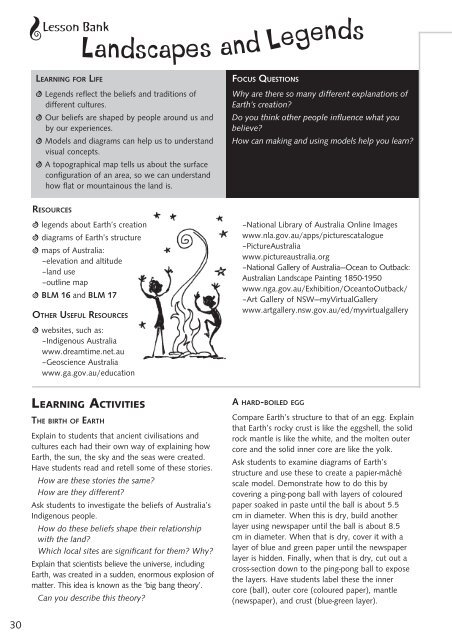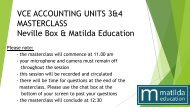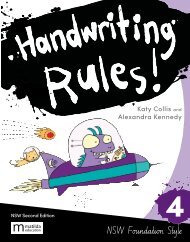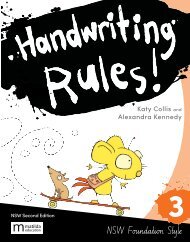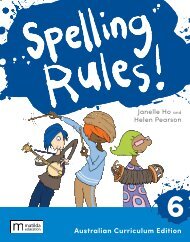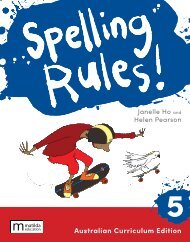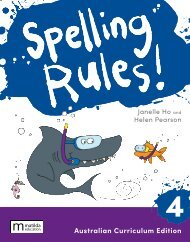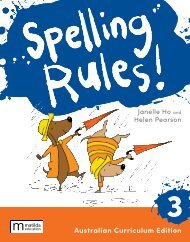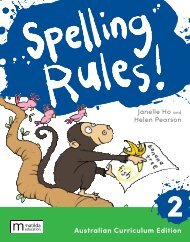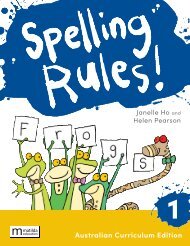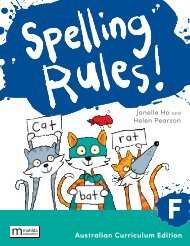All You Need to Teach - Info Literacy 10+
Create successful ePaper yourself
Turn your PDF publications into a flip-book with our unique Google optimized e-Paper software.
Lesson Bank<br />
Landscapes and Legends<br />
Learning for Life<br />
V Legends reflect the beliefs and traditions of<br />
different cultures.<br />
V Our beliefs are shaped by people around us and<br />
by our experiences.<br />
V Models and diagrams can help us <strong>to</strong> understand<br />
visual concepts.<br />
V A <strong>to</strong>pographical map tells us about the surface<br />
configuration of an area, so we can understand<br />
how flat or mountainous the land is.<br />
Focus Questions<br />
Why are there so many different explanations of<br />
Earth’s creation?<br />
Do you think other people influence what you<br />
believe?<br />
How can making and using models help you learn?<br />
Resources<br />
V legends about Earth’s creation<br />
V diagrams of Earth’s structure<br />
V maps of Australia:<br />
–elevation and altitude<br />
–land use<br />
–outline map<br />
V BLM 16 and BLM 17<br />
Other Useful Resources<br />
V websites, such as:<br />
–Indigenous Australia<br />
www.dreamtime.net.au<br />
–Geoscience Australia<br />
www.ga.gov.au/education<br />
–National Library of Australia Online Images<br />
www.nla.gov.au/apps/picturescatalogue<br />
–PictureAustralia<br />
www.pictureaustralia.org<br />
–National Gallery of Australia—Ocean <strong>to</strong> Outback:<br />
Australian Landscape Painting 1850-1950<br />
www.nga.gov.au/Exhibition/Ocean<strong>to</strong>Outback/<br />
–Art Gallery of NSW—myVirtualGallery<br />
www.artgallery.nsw.gov.au/ed/myvirtualgallery<br />
Learning Activities<br />
The birth of Earth<br />
Explain <strong>to</strong> students that ancient civilisations and<br />
cultures each had their own way of explaining how<br />
Earth, the sun, the sky and the seas were created.<br />
Have students read and retell some of these s<strong>to</strong>ries.<br />
How are these s<strong>to</strong>ries the same?<br />
How are they different?<br />
Ask students <strong>to</strong> investigate the beliefs of Australia’s<br />
Indigenous people.<br />
How do these beliefs shape their relationship<br />
with the land?<br />
Which local sites are significant for them? Why?<br />
Explain that scientists believe the universe, including<br />
Earth, was created in a sudden, enormous explosion of<br />
matter. This idea is known as the ‘big bang theory’.<br />
Can you describe this theory?<br />
A hard-boiled egg<br />
Compare Earth’s structure <strong>to</strong> that of an egg. Explain<br />
that Earth’s rocky crust is like the eggshell, the solid<br />
rock mantle is like the white, and the molten outer<br />
core and the solid inner core are like the yolk.<br />
Ask students <strong>to</strong> examine diagrams of Earth’s<br />
structure and use these <strong>to</strong> create a papier-mâché<br />
scale model. Demonstrate how <strong>to</strong> do this by<br />
covering a ping-pong ball with layers of coloured<br />
paper soaked in paste until the ball is about 5.5<br />
cm in diameter. When this is dry, build another<br />
layer using newspaper until the ball is about 8.5<br />
cm in diameter. When that is dry, cover it with a<br />
layer of blue and green paper until the newspaper<br />
layer is hidden. Finally, when that is dry, cut out a<br />
cross-section down <strong>to</strong> the ping-pong ball <strong>to</strong> expose<br />
the layers. Have students label these the inner<br />
core (ball), outer core (coloured paper), mantle<br />
(newspaper), and crust (blue-green layer).<br />
30


